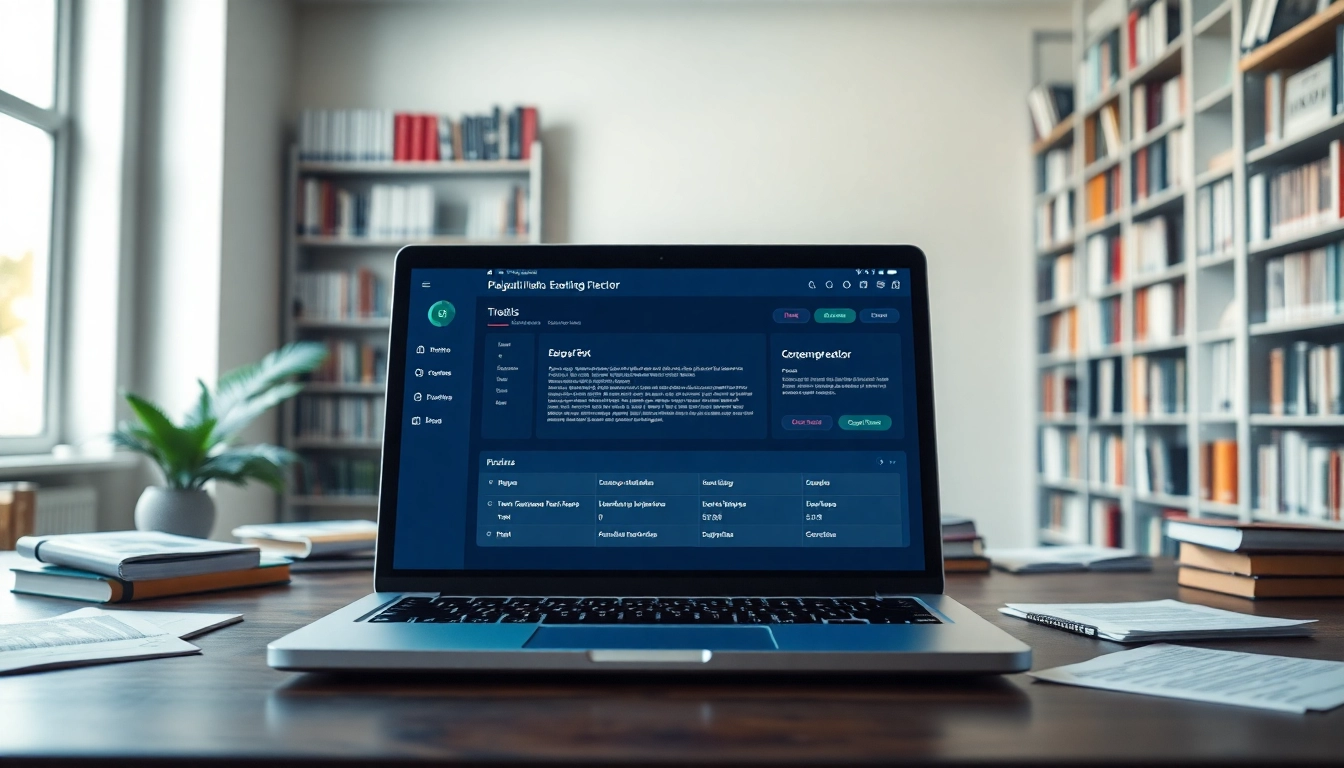Understanding Plagiarism Detectors: What You Need to Know
Definition and Purpose
A plagiarism detector is a sophisticated tool designed to identify instances of plagiarism within a text by comparing it against a vast database of published works. The primary purpose is to ensure the integrity of academic and professional writing by highlighting unoriginal content. This is especially vital in educational environments where the authenticity of student submissions is critical. By utilizing a plagiarism detector, educators can uphold standards of originality and provide students with the feedback they need to improve their writing skills.
Types of Plagiarism Detectors Available
Plagiarism detectors come in various forms, primarily categorized into three types:
- Web-based Tools: These are accessible online and offer quick checks for plagiarism. Many are free or offer premium services for advanced features, making them popular among students and educators alike.
- Software Applications: Standalone applications require installation and often provide more comprehensive features for those who need extensive batches of written work analyzed.
- Institutional Tools: Many schools and universities subscribe to enterprise-level software, such as Turnitin, designed to tightly integrate with their educational frameworks and provide robust checks across numerous submissions.
How They Operate: The Technology Behind Detection
Most plagiarism detectors analyze text through complex algorithms that match words, phrases, and ideas against an extensive database comprising academic works, online articles, and other publicly accessible texts. When a user submits a document, the detector generates a similarity report, pinpointing any sections that match existing works. Key technologies involved include:
- Text Matching: This involves scanning texts for similarities in structure and wording.
- Semantic Analysis: Some advanced detectors employ AI-driven semantic analysis to understand context, allowing for the identification of paraphrased content.
- Machine Learning: Periodically updated databases leverage machine learning techniques to enhance the accuracy of text matching and reduce false positives.
The Importance of Using a Plagiarism Detector
Academic Honesty and Integrity
The role of plagiarism detectors is paramount in fostering a culture of academic honesty. With the increase in digital resources, students may inadvertently or intentionally incorporate others’ work into their own without appropriate citations. Regular use of a plagiarism detector discourages these practices, reinforcing the importance of original thought and responsible scholarship.
Benefits for Students and Educators
For students, utilizing plagiarism detection tools serves multiple benefits:
- Improved Writing Skills: By understanding the areas where they may be prone to unintentional plagiarism, students can learn to paraphrase effectively and cite sources correctly.
- Additional Feedback: These tools not only identify plagiarism but also provide insights into overall writing quality, such as sentence structure and grammar.
Educators benefit similarly, as they can maintain high standards without dedicating excessive time to manually checking submissions for originality. In essence, plagiarism detectors facilitate a more streamlined approach to upholding academic integrity.
Avoiding Comprehensive Academic Consequences
Failure to properly attribute sources or present original work can lead to serious academic repercussions, including failure of assignments, revocation of degrees, or expulsion from institutions. By employing plagiarism detectors, both students and educators can safeguard against such outcomes, fostering a healthier educational environment.
How to Choose the Right Plagiarism Detector
Key Features to Look For
When searching for an effective plagiarism detector, specific features should be prioritized to ensure optimal functionality and performance:
- Comprehensive Database: A tool should boast a wide-ranging and continually updated database to provide accurate results.
- Advanced Reporting: Look for detailed reports that highlight matches, the percentage of similarity, and links to the original sources.
- Multiple File Formats: Ensure that the tool supports various document types such as Word, PDF, and more.
- User-friendly Interface: The interface should be intuitive, making it easy for users to navigate the functionalities.
- Integration Capability: Some tools offer integration with LMS platforms or writing software, which can ease the workflow.
Comparing Free vs. Paid Tools
The choice between free and premium plagiarism detectors hinges on individual needs. Free tools can be advantageous for casual users or students needing occasional checks; they often have limitations regarding database size and functionality. In contrast, paid services typically offer extensive resources, accuracy, and additional features, making them worthwhile investments for academia or professional writing.
User Reviews and Recommendations
User reviews can provide valuable insights into a plagiarism detector’s reliability and effectiveness. Potential users should seek platforms that aggregate user feedback, allowing them to compare based on performance, accuracy, and customer support. Sites like Trustpilot and independent educational forums can be excellent sources of information when selecting the best tool.
Best Practices for Using a Plagiarism Detector
How to Interpret Results Effectively
Interpreting the results from a plagiarism check requires a nuanced understanding of the report generated by the detector. Users should focus on:
- Similarity Score: This metric indicates how much of the content resembles existing texts. A lower score generally suggests originality; however, context is also crucial.
- Identified Matches: Review highlighted sections and their sources to understand where overlaps exist and whether they are appropriately quoted or paraphrased.
- False Positives: Not all matches will indicate plagiarism. Common phrases or results from common knowledge should be evaluated critically.
Integrating Feedback into Your Work
Once results are reviewed, it is essential to act on the feedback. Writers should revisit their work, modify problematic sections, add necessary citations, and ensure that their voice remains intact. Emphasizing revision will enhance both the integrity and quality of the writing.
Preventing Future Issues with Plagiarism
To avoid future instances of plagiarism, adopt proactive writing habits. This includes maintaining accurate citation records, understanding proper formats, and developing strong paraphrasing skills. Additionally, regular use of a plagiarism detector during the writing process can catch potential issues before submission, fostering a proactive approach to originality.
Case Studies: Successful Use of Plagiarism Detectors
Institutions Emphasizing Plagiarism Checks
Many universities have adopted plagiarism detection software as a standard practice. For instance, institutions like Harvard and Stanford require students to submit papers through software like Turnitin, significantly reducing instances of plagiarism and promoting academic integrity. These programs not only help detect potential academic dishonesty but also act as learning tools for students.
Real-Life Scenarios of Successful Detection
Consider a college where a significant number of students were accused of plagiarism on final projects. Following the implementation of a plagiarism detector, instructors were able to identify and address issues effectively. Many students opted to resubmit their projects with the necessary changes based on the reports. This initiative led to a remarkable drop in plagiarism rates in subsequent semesters.
Ongoing Developments in Plagiarism Detection Technology
The field of plagiarism detection is continually evolving. Recent advancements feature the integration of AI and machine learning, enhancing the ability to detect not only identical content but also rephrased material. These technologies promise improved accuracy and efficiency, significantly benefiting both educators and students in the long term. As detection tools advance, so too must the understanding and usage of these technologies within academic and professional settings.















Leave a Reply